
December 2010
John Vincent Bellezza
Once again the Flight of the Khyung swoops down to earth, carrying with it the mysteries of ancient Tibet, and just in time for this holiday season! I have fascinating bits and pieces for you this month. Let us begin with a discovery from this year’s Upper Tibet Rock Art Expedition.
A strange spell from atop a mountain
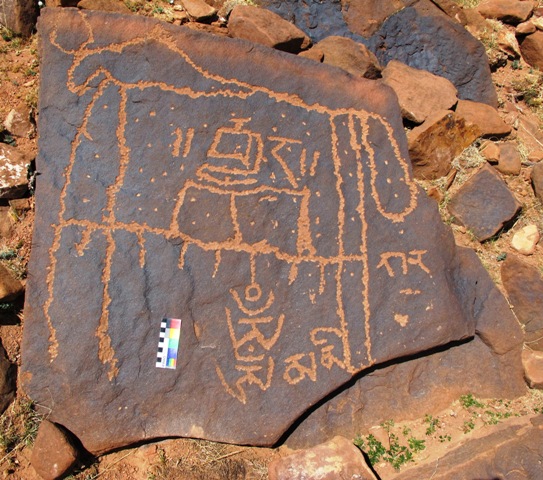
Fig. 1. A carved yak accompanied by six or seven Tibetan syllables, early historic period
This petroglyph was documented atop a flat-topped mountain in the western Changthang at nearly 5000 m above sea level. The yak (probably the wild variant, recognizable by its horns, hump and belly fringe) and inscription belong to the early historic period (650–1000 CE) of rock art carving in Upper Tibet. Early historic period carvings tend by turns to be more crudely executed or with more realistic depictions than earlier rock art, and that holds true for this particular site. In the upper portion of the body of the yak the syllable rgyang has been written. It is flanked by double lines (gnyis-shad) highlighting its stand-alone importance. While rgyang is a common word in the Classical Tibetan language, its Old Tibetan meaning here is uncertain. Rgyang, in one Old Tibetan text I am now working on means ‘far away’, one of its senses in Classical Tibetan, but that definition doesn’t really seem to fit here. If instead we read this syllable as rgyad (which is less likely given the formation of the letters), then, it could be the Old Tibetan word for the number ‘eight’. Below rgyang it appears that ga was written, however, this letter is rendered in a non-standard fashion with a very long horizontal upper stroke. Below the hairy belly of the yak it reads: Om Om, ma mi, and below the tail: kar (Old Tibetan = white). These five syllables make up a spell or mantra, all five syllables of which are found in current Bon esoteric religious usage. However, this mantra has a primitive ring about it. It may translate as: “Hail Om (the male principle of existence) ma (the female principle of existence) white humans”, but this is purely conjectural on my part. In any case, this inscription seems to be a precursor of the lamaist Bon mantras that appeared circa the 11th century CE.
The all-stone corbelled shrines of western Tibet and Ladakh
While the great epoch of all-stone corbelled architecture in Upper Tibet and Ladakh was in prehistoric times, certain early historic period religious edifices in the region were also constructed in this manner. In the just about to be released two volume series entitled “Antiquities of Zhang Zhung”, you can read about them and view images of such sites. The good news is that these large volumes will be absolutely free on the Tibetan Himalayan Library website (thlib.org). If you can’t wait until the final version is launched, just send me an email, I would be happy to give you the staging link for the website.
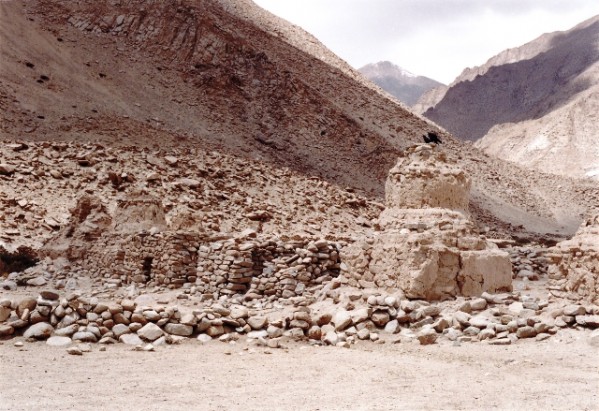
Fig.2: Chorten Dunbu, probably 11th century CE. It is claimed by local residents that each of the two middle specimens were once topped by five bumpa (bulbous structures)
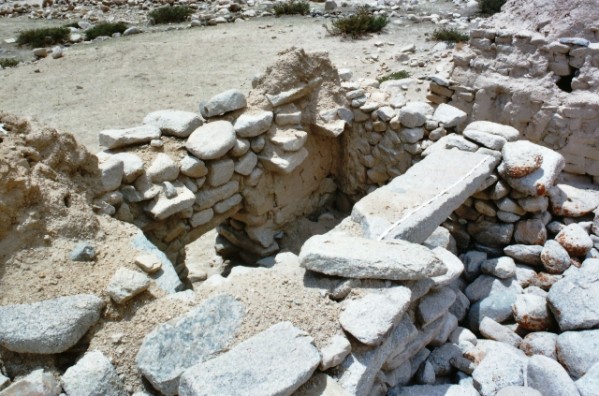
Fig. 3: Chorten Dunbu, Chorten MT3. Note the in situ bridging stone over the open chamber and the stone lintel over the low entranceway.
On a much more modest level, the tradition of all-stone corbelled architecture in western Tibet and Ladakh continued until well into the 11th century. This later tradition pertains to the ruined shrines known as chortens. In Ruthok, at the site called Chorten Dunbu (Seven Chortens), there are six ruined chortens set in the middle of abandoned agricultural fields (given the name, I suppose there were once seven of them). Local elders state that these chortens were built by an ancient tribe known as the Mon. These ceremonial structures were mainly constructed from granite blocks and corbels but some adobe blocks are also interspersed in the courses.
A number of all-stone corbelled chortens have also been catalogued in Ladakh by my colleague, Quentin Devers, a PhD candidate at the École Pratique des Hautes Études (Paris) and member of the Centre de Recherche des Civilisations d’Asie Orientale. He is compiling an inventory of fortifications, temples and rock art in Ladakh and Zanskar, dating from the Bronze Age upto the second diffusion of Buddhism. Be on the look out for Quentin’s future publications because he is making some very major strides forward in our understanding of the archaeology and cultural history of Ladakh and Zanskar. Site information and photographs on the following all-stone corbelled chorten sites come from Quentin Devers.
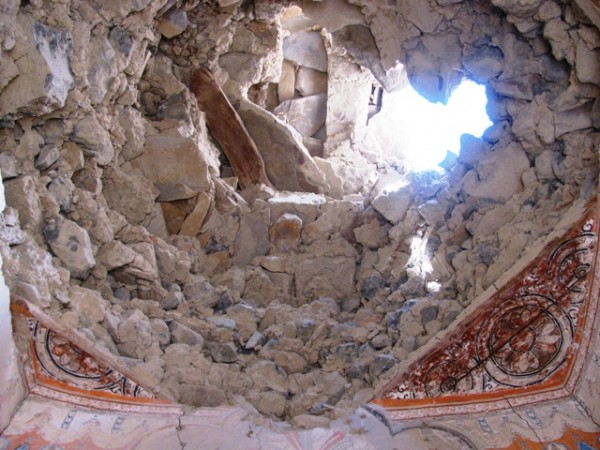
Fig.4: A close-up of the corbelling technique used in one of the chortens of Malakhartse (Zanskar), 11th century CE. The frescoes of this chorten were published by Rob Linrothe in the May 2007 issue of “Orientations” in his excellent article, “A Winter in the Field”. Photo by Quentin Devers

Fig.5: A precious pargetted chorten image on exterior wall of same chorten of Malakhratse. This image in stucco furnishes us with an excellent sample of how chortens of the 11th century CE were once conceived in the region. Photo by Quentin Devers
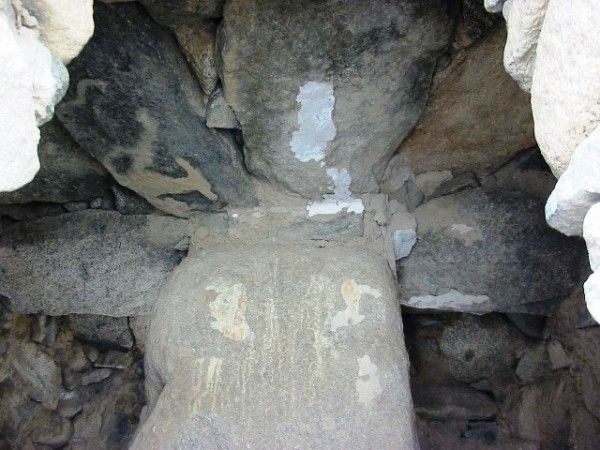
Fig.6: Interior of chorten at Nang. This highly unusual and very adept construction employed an intermediary pillar to support the bridging stones. Photo by Martin Vernier
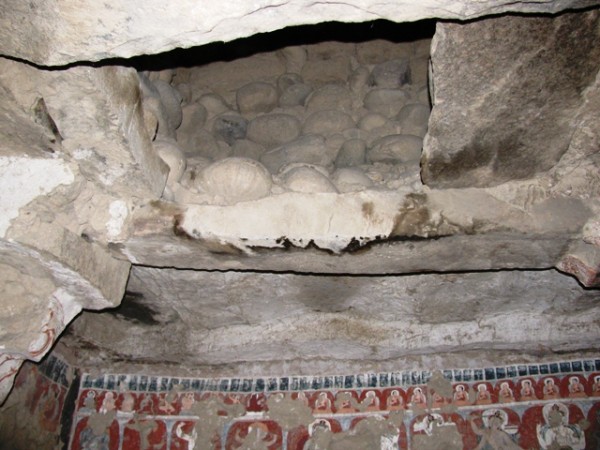
Fig.7: Interior of one of the chortens at Nyarma (Ladakh). Note the old-stone roof assembly consisting of corbels, bridging stones and slab sheathing. Also note the registers of murals dating to circa the 11th century CE. Photo by Quentin Devers
The chorten of Nyarma pictured above was first documented by the art historian Christian Luczanits, who decided not to publish it until the site could be better protected. Informing his colleague Gerald Kozicz about the discovery, the latter went to the site and published an article about it in the May 2007 issue of “Orientations” (see “Documenting the Last Surviving Murals of Nyarma”), without even having the decency to mention Christian Luczanits in his article. I hasten to add that this is not the first example of such nonsense in Ladakh studies, much of its dirty laundry being aired most publically. You might fool the rest of us with your tricks for a little while, but in the long-run plagiarizers and the unethical are caught out!
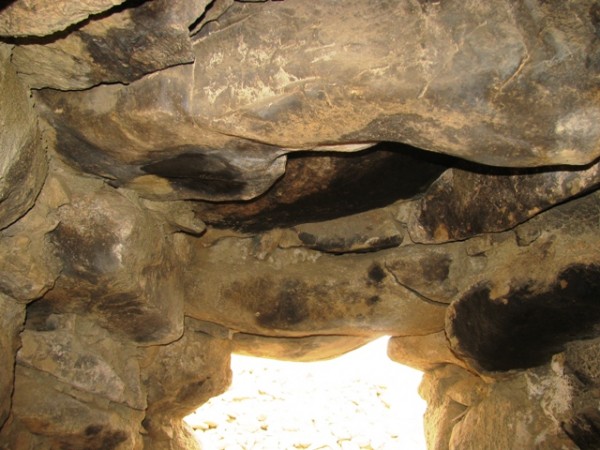
Fig.8: The robustly constructed interior of a chorten at Shernos, upper Ladakh. Photo by Quentin Devers
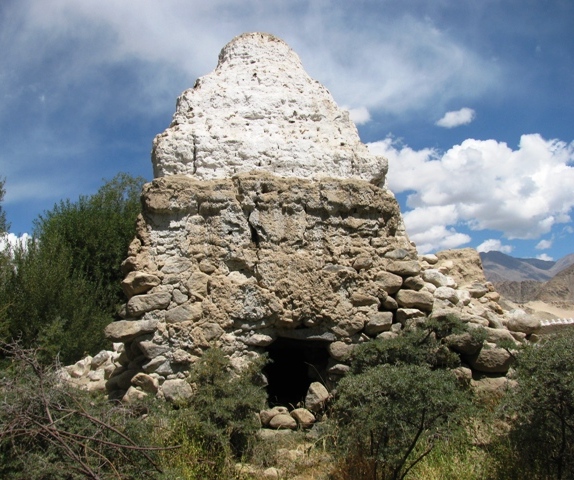
Fig.9: One of the two all-stone-corbelled chortens between Thikse and Nyarma (Ladakh), photo by Quentin Devers
From these photographs of all-stone corbelled chortens in Ruthok, Ladakh and Zanskar it can be readily seen that there are three major corbelled typologies represented: 1) the use of bridging stones to span long open spaces (Chorten Dunbu, Shernos, Thikse, Nyarma), 2) the construction of a corbelled arch with no bridging stones (Malakhartse), and 3) the use of a central pillar to support the roof assembly (Nang). As for the age of these chortens, they can be quite confidently dated to the 11th or 12th century on the basis of accompanying murals and the architecture style of the chortens (from as much as can still be seen). The features that reflect this kind of antiquity include stepped bases with interconnecting steps, squat bumpas and truncated pyramidal spires. The oral tradition linking some of these chortens to that nebulous ancient group known as the Mon is also indicative of considerable antiquity. Furthermore, this periodization is supported by rock art chortens with and without inscriptions found in the greater region.
The construction of chortens using corbelling was the final chapter in an architectural tradition that began many centuries earlier in the first millennium BCE. By circa 1000 CE, the skills and resources needed to build extensive edifices using the corbelling techniques of Upper Tibet appears to have vanished. This disappearance can also be attributed to cultural and social changes. No longer did elite sections of the population want to live in windowless, often semi-subterranean structures. Nevertheless, a vestigial capability in designing corbelled architecture persisted, as manifested in the chortens we have been examining. That corbelling was still being used in construction circa 1000–1100 CE is mirrored in the famous legendary contest between the 11th century CE yogin Milarepa and Naro Bonchung, in which slabs of stone as long as an ‘eight-year old child’ were used to make the roof of a house.
Rare collectable artifacts from Upper Tibet
In my attempt to comprehensively document the artifacts of ancient Upper Tibet, I was kindly aided by a Tibetan named Shang Nyima. He is a collector of Tibetan antiques and he recently opened up his collections to me for study. Of particular interest are two copper alloy objects that belong to a class of castings of Upper Tibetan origin. These types of artifacts are discovered by herders and farmers in the region, as I have documented on a number of occasions. They are often referred to as thokcha (thog-lcags), objects with talismanic power.
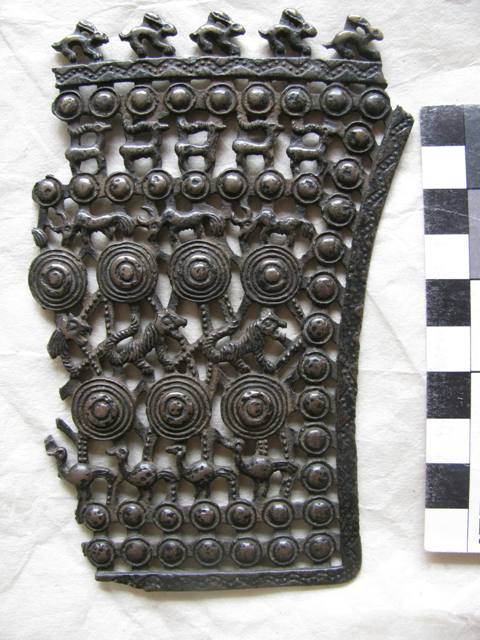
Fig.10: A wedge-shaped openwork copper alloy object in which there are five horizontal rows of animals and shield-like discs, protohistoric period. Nearly half of this object is missing. Shang Nyima collection
This splendidly cast object features five rows of animals; from top to bottom they include rabbits, antelope or ibex, wild yaks, tigers, and birds (cranes or waterfowl?). Interspersed between each row of animas are discs that come in two sizes, the larger of which is embossed with concentric circles. Beading and a wave-like design (chu-ris) ornament the border. The animals represented are among those that play an important role in the cultural history of the region. I am not certain as to the function of this article, save that it appears to have had ritual or ceremonial value. Such an elaborate instrument would have been the possession of an individual / individuals of relatively high social status. Perhaps it was used as a sacred ornament on clothing or alternatively, in a ritualized array. The lines of animals and other motifs seem to convey a narrative and / or symbolism of great intricacy, but what this might have been I am not yet prepared to say. It is rumored that a similarly sized and designed fully intact example was sold not long ago in New York City, but I have no details. If anyone does or knows of other examples, please contact me. Collectors and dealers are not usually scholars and the goods they handle often never see the light of day for study.
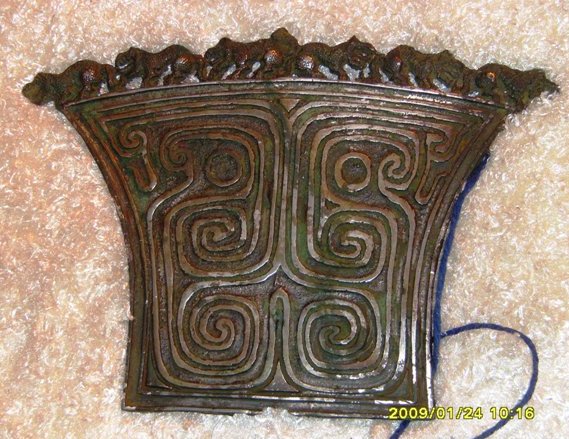
Fig.11: A wedge-shaped, nearly flat copper alloy object with curvilinear designs and a row of tigers, protohistoric period. Shang Nyima collection and photograph
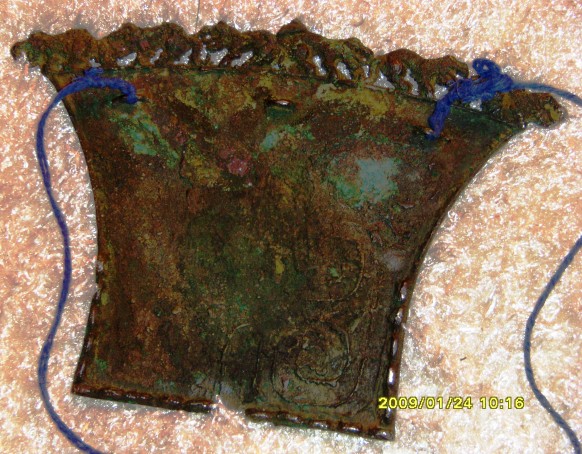
Fig. 12: The reverse side of the same object. Note the three small rings for attachment near the top of the object and the series of rings bordering its lower half. Also note the way in which the design on the obverse side is imprinted on the back. Shang Nyima collection and photograph
This is the same general type of object as above, but somewhat larger in size, unperforated and with the benefit of being whole. Like its counterpart, it is superbly modeled and cast, and the metal used is of very high quality. The masses of curling lines may depict the whorls on the coat of the tiger. In one propitiatory (gsol-kha) text I have translated, it speaks of the six whorls of a tigress, a mount of the Upper Tibetan mountain god Namra. On top of the object is a row of six tigers (?), three facing in one direction and three in the other direction. Despite being physically degraded, these great carnivores still exhibit much dynamism. We know that the tiger was an ancient cult symbol of Tibetan warriors, their costumes and weapons being conceived of in the form or manner of this great feline. This object was invested with much ritual or ceremonial value, but what that constituted remains a mystery. Any ideas?
Next month: Plenty more archaeological discoveries and other things in store for you too!